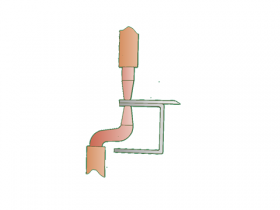
Design
Questions and Answers
Edge distance is a very important design criteria in resistance welding. Any weld on an edge can expel metal and or result in a partial weld nugget. This type of weld is considered deficient in quality programs. Edge welds should be avoided in all design and set up situations.
Part fit up is very important in determining the quality of resistance welds. All weld schedules call out a force value with the purpose of holding the part together, containing the weld nugget and performing a little forging as the weld cools. If the part does not fit up properly then part of this force is used to force or form the part into place and is not available to contain and forge the weld nugget.

ALIGNMENT, FIT UP & WORN CYLINDERS CAN CASUE PROBLEMS
Resistance welding over a lip, in a corner, or in a box might be a perfect application for a double bend electrode.

Above is a sketch showing an example of a double bend electrode welding in a tight area. There are many applications like this that a double bend full size electrode or double bend shank and cap will allow you to reach an otherwise difficult location to weld. Double bends can be water cooled to increase life. Double bends come in many offsets and sizes as shown below.

DOUBLE BEND ELECTRODES
Reference: RWMA - Resistance Welding Manual 4th Edition
SINGLE AND DOUBLE BENDS CAN REACH THAT EXTRA DISTANCE IN RESTRICTED AREAS

Sometimes we have to reach inside a box or over a feature in a part that stretches our imagination. A double bend electrode might be the answer but a single bend electrode might also get us that extra distance. Both can be water cooled and deliver good force into restricted areas.

Reference: RWMA - Resistance Welding Manual 4th Edition
Electrodes are available in many sizes and shapes to fit most needs in industry. To choose many considerations come to mind. The first decision would be full size vs cap electrode. Are you a job shop or highly automated usually decides this.
Page 1 of 2
Have a Question?
Do you have a question that is not covered in our knowledgebase? Do you have questions regarding the above article? Click here to ask the professor.
